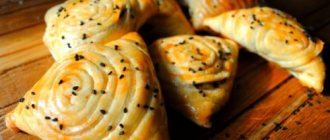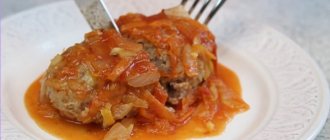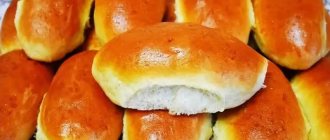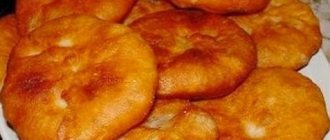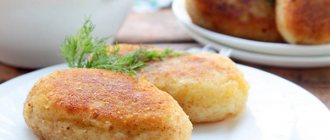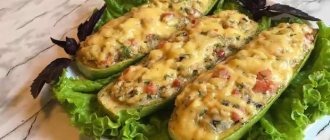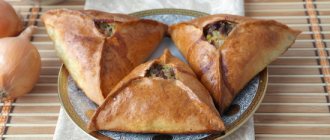Required Products
- Flour - three glasses.
- Minced meat – one kilogram.
- Cottage cheese - two packs.
- Onion - two large heads.
- Salt - one teaspoon.
- Eggs - four pieces.
- Baking powder - three teaspoons.
- Thyme – one teaspoon.
- Baking powder - one teaspoon.
- Dried garlic - one teaspoon.
- Pepper - half a teaspoon.
- Oil - half a glass.
Baking with cheese and chopped egg
If you really want something tasty, but you only have ready-made dough (butter) bought in a store, and even guests show up unexpectedly, you can try baking shangi with cheese and egg according to the recipe presented later in the article. The filling used is:
- boiled eggs (chopped);
- green onions (chopped);
- cheese (grated);
- for the mix: sour cream or mayonnaise.
Preparing shanezheki
You need to start with the onion, peel it, rinse it and chop it into small cubes. Pour oil into a frying pan and put on fire; when the oil is hot, add the onion and stir with the oil. Fry the onion over low heat until slightly golden, remembering to stir so that it does not burn. Remove the finished onion from the heat.
Next, you need to prepare the dough for the meat buns. To do this, take a fairly large bowl and sift the flour into it. Then add the remaining ingredients to the flour one by one: cottage cheese, salt, eggs and baking powder. First, you can mix with a spoon, and then knead the dough until it has a homogeneous consistency. It should turn out soft and not stick to your hands.
Place the fried onion in a separate bowl, add minced meat to it, add black pepper, thyme, salt and dry garlic. Mix the minced meat, onion and spices well. Using the recipe with photo to prepare shanezheki with meat, you can quickly prepare the dough and filling. Now you can begin the process of making the shawls themselves.
Sprinkle a small amount of flour on a clean and dry table and place the dough on it. Try to roll out the dough into a square shape. To do this, you need to start rolling out the dough from the middle to the edges, gradually giving it the shape of a square. It is necessary to spread the meat filling in an even layer on the rolled out layer of dough, leaving about one centimeter from the edge without filling, this will make it easier and more convenient to pinch the roll at the end.
Now you need to tightly roll the dough with minced meat into a roll and carefully secure the edge so that later during the frying process the buns do not separate. The last thing to do is cut the resulting roll with a knife into pieces of the same size. The width of each piece of meat should be no more than one and a half centimeters. Otherwise, there is a chance that the minced meat will not be fully cooked.
Pour oil generously into a non-stick frying pan and place on heat. After the frying pan has warmed up, place the pancakes on it. Over low heat, fry first on one side and then on the other until golden brown. Since a large amount of oil is used when frying, after preparing the meat shank, it is advisable to first place it on a wire rack to drain the oil, and then onto a plate. They can be consumed both hot and cold. In any form, they will be a tasty and satisfying dish on your table.
Delicious flour products with buckwheat and mushrooms
List of required products:
- 400 grams of flour;
- ¼ liter of water;
- ten grams of yeast;
- 30 grams of granulated sugar;
- 100 ml sunflower oil;
- 100 g buckwheat;
- ¼ kilogram of champignons;
- bulb.
Lenten shangi are prepared as follows:
For the dough, mix sugar, yeast, 50 ml of warm water and leave for half an hour. Pour flour, salt to taste, butter and yeast mixture into a deep bowl. After kneading, the dough is left alone for a while until it rises. The filling for shaneg is made as follows way: boil buckwheat until completely swollen. Onions and mushrooms are cut and fried until fully cooked. The porridge and vegetables are mixed, salted and spices are added. The dough is divided into parts, each piece is formed into a thin flat cake. The filling is placed inside. Cook for 20 - 25 minutes, temperature 180 °C.
Preparation
Peel the onion, wash and chop into small cubes. Heat a frying pan, pour oil and sauté the onion until golden brown, remembering to stir. Place the prepared onion in a bowl, place the minced meat in it, add ground pepper and salt. You can also add spices at your discretion. Beat in two eggs; if desired, you can also add finely chopped parsley and dill. Mix the minced meat with all the other ingredients very carefully.
Once the filling is ready, you can start kneading the dough. Sift wheat flour into a separate bowl, beat in two eggs, add salt, pour in warm boiled milk and pork fat, previously melted in a water bath. Knead soft, elastic dough. Sprinkle a small amount of wheat flour onto the work surface. Place the finished dough on it and slowly roll it out carefully. It is advisable to give the dough the shape of a rectangle.
Place the prepared meat filling on the rolled out dough and spread it over the entire surface of the dough, be sure to leave one side one and a half centimeters without filling, so that later it will be easier to join the edge. The dough with filling should be rolled into a roll and the edge should be pinched. Then, using a sharp knife, cut the roll into equal pieces one to two centimeters wide. The next thing to do is grease a baking tray, cover it with baking foil and place the meatballs on it. Photos of baked goods can be seen in the article, having learned in advance what the finished cakes will look like.
Preheat the oven to one hundred and ninety degrees, place a baking sheet in it and bake for fifty minutes. The pancakes should be browned. At the end of baking, melt a little butter in a water bath. As soon as the meat shanks are ready, immediately brush them with butter. Shanezhki turn out juicy on the inside and crispy on the outside. All that remains is to place the baked goods on a plate and serve this wonderful addition to a cup of your favorite drink.
First - grammar
Before we begin the story about what “shanga” is, let’s say that the word is a noun, inanimate, singular, feminine, first declension. The stress in this form and in all others falls on the first syllable.
In the singular, the word changes by case, taking the following forms:
- shanga - (named case, answers the question “what?”)
- shangi (born pad., what?)
- shange (Dan. fall., why?)
- shangu (vin. pad., what?)
- shangoi (creative pad., what?)
- shange (prepositional fall., about what?)
In the plural it has the form “shangi”, in the genitive plural - “shaneg”, in the dative case - “shangam”.
The word could be used in diminutive forms. For example, Shanezhka, Shanechka. It had a numerous synonymous series: flatbread, sochnya, cheesecake, unleavened bread, pyzhka, pancake, pancakes (aladushki), kokurka, bread, kazulka.
What is shanga
Shanga (or as they are affectionately called “shanezhki”) is a flour dish that belongs to Russian cuisine. It is believed that shanezhki were adopted from Finnish tribes in ancient times. Gradually, Russian colonists explored the lands, new settlements appeared in the east, and with them their culinary traditions passed on. Thus, the dish spread from the North to the Urals, and then to Siberia.
Shangi are open pies covered with “filling” (spread). In appearance they even look more like round fluffy cakes.
They are prepared from yeast or yeast-free dough based on wheat or rye flour. The dough is also usually kneaded with animal fat (lamb, beef, etc.).
The filling most often used is mashed potatoes, porridge, sour cream mixed with flour, and various additions such as fried mushrooms, onions, and herbs. Of course, modern variations can be made with cheese, meat and other ingredients. It can also be noted that for traditional shanga they do not make sweet fillings.
Shanga is very similar to cheesecake, some even consider these two names to be synonymous with one dish. I will say right away that this is not so. Then how do these cakes differ from each other?
In fact, there are not so many obvious differences. I made a couple of extra movements and that’s it - instead of shanezheki I got cheesecakes or vice versa.
- Shangi, unlike cheesecakes, are not sweet. Even if cottage cheese is added, it is without sugar and other sweet additives.
- Another difference is that cheesecake flatbreads have a cavity that is filled with filling. Shanezhki are simply lubricated from above. No special indentations are made in the dough.
- The third difference is that the filling for cheesecakes is usually located in the center. The shangs are completely lubricated to the edges.
Additional Information
Shanga (pl. shangi
;
mind-affectionate shanezhki
)
The name of this dish was borrowed by the Slavic population of the Russian North from the language of the aboriginal Finnish tribes. Then, together with the settling Northern Russian population, it spread from Karelia to the Ob.
Today, the dish is widespread in home cooking in the Cis-Urals, Middle Urals and Trans-Urals.
Today shangi are made mainly from sour yeast dough. In the old days, Komi-Permyak cuisine also had shangi made from unleavened dough, the so-called “kuliggez” (“kuligi”).
In Veliky Ustyug and the Perm region, shangi are still more often made from unleavened dough and are widely used in local cuisine.
Shanezhki, unlike cheesecakes, are practically never sweet. The filling can be different: potatoes, porridge (millet, peas), cottage cheese, just thick sour cream...
November 14 o
Perm shangi-shanezhki taught me how to bake many years ago, my friends from this wonderful city. Or rather, not they themselves, but their grandmothers, who are already far from “over” - God bless them!))))
This dish is a mixture of Russian and Finno-Ugric cuisine. Simple, hearty, very tasty...
Perm is a city in the east of the European part of Russia, in the Urals.
The word Perm comes from the Vepsian word perämaa
- “distant land”.
In 1876 The first railway in the Urals passed through Perm, and the first university in the Urals was opened in 1916.
A beautiful, harsh region... An industrial, scientific and cultural center.
There is a humorous name for Permians: “Permyak - salty ears”))) It appeared from the beginning of the work of salt mines in the city of Solikamsk, Perm Territory. According to legend, workers carried the mined salt in bags on their backs, it spilled onto their heads and onto their ears, causing them to become salty.)))
In the Perm region there is an amazing open-air architectural and ethnographic museum - Khokhlovka.
It includes 23 unique monuments from the late 17th to the first half of the 20th centuries. These are various wooden buildings and structures brought here from other places and representing the best examples of folk construction and artistic culture of the region. Many monuments have ethno-stylized interiors and exhibition complexes
